Characterization of Intra-Quarry Variability in Pentelic Marble Using Stable Isotopes: A Case Study of the Parthenon
Abstract
:1. Introduction
2. Materials and Methods
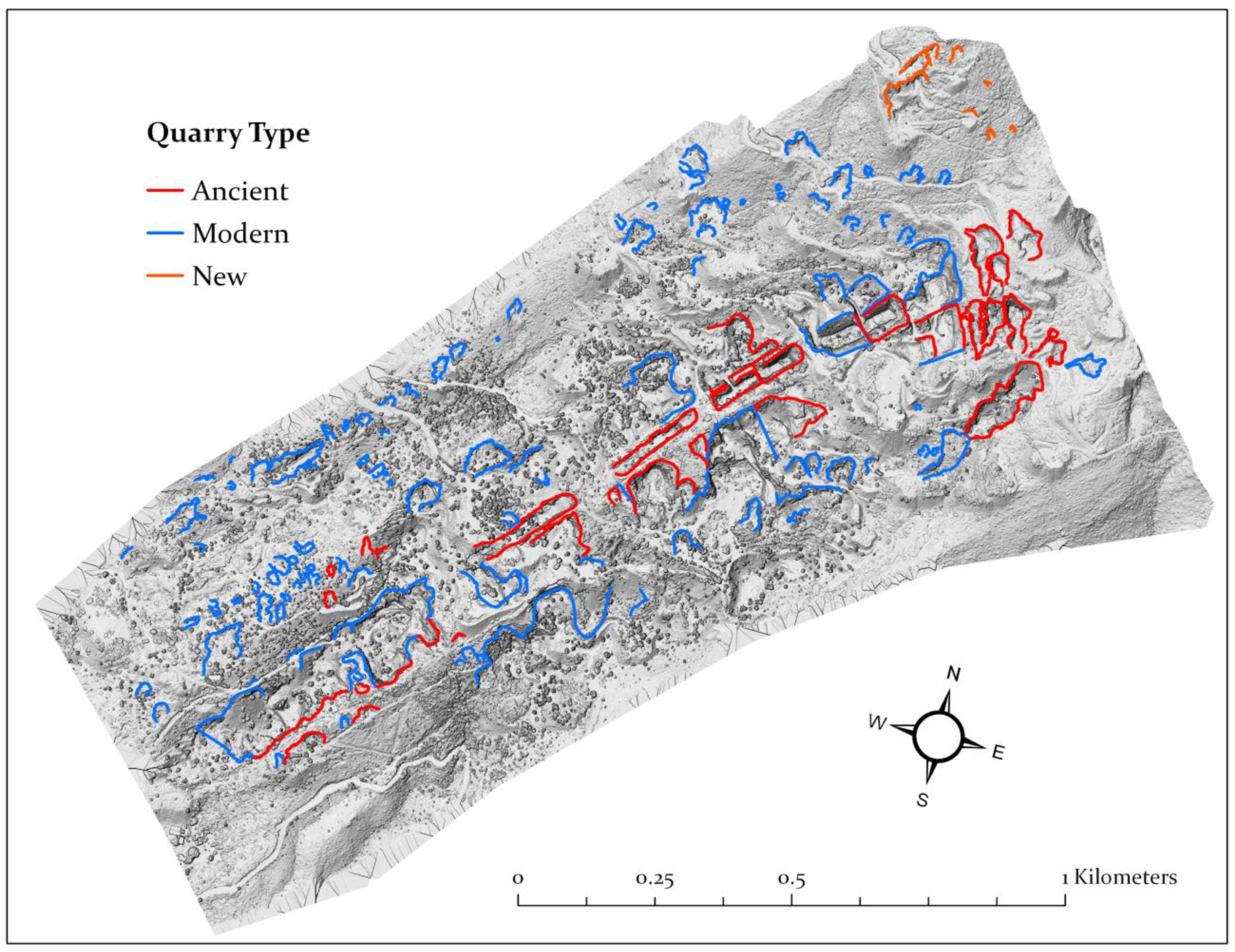

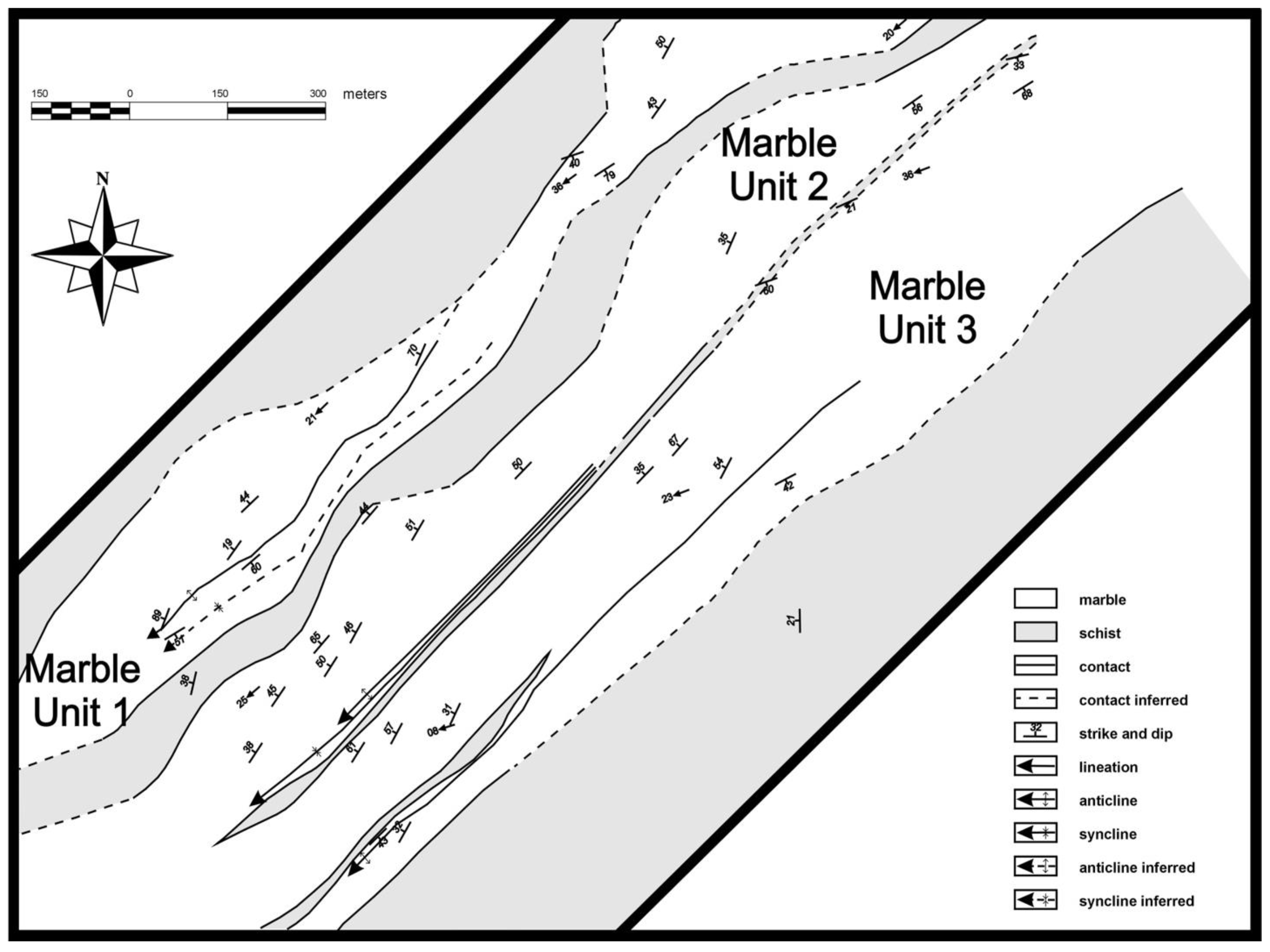
3. Results
4. Discussion
5. Conclusions
Funding
Data Availability Statement
Acknowledgments
Conflicts of Interest
Appendix A
| Quarry | Sample ID | δ13C | δ18O |
|---|---|---|---|
| 4 | 4-1 | 4.2 | −7.2 |
| 4 | 4-2 | 3.8 | −6.5 |
| 11 | 11-1 | 4.0 | −7.8 |
| 12 | 12-1 | 4.3 | −7.1 |
| 12 | 12-2 | 2.7 | −8.2 |
| 12 | 12-3 | 3.8 | −9.1 |
| 13 | 13-1 | 3.9 | −7.6 |
| 13 | 13-2 | 3.6 | −8.6 |
| 14 | 14-1 | 4.1 | −7.6 |
| 15 | 15-1 | 4.6 | −7.0 |
| 15 | 15-2 | 4.5 | −7.4 |
| 16 | 16-1 | 4.7 | −7.6 |
| 16 | 16-2 | 4.8 | −7.1 |
| 17 | 17-1 | 4.8 | −7.6 |
| 20 | 20-1 | 5.0 | −7.1 |
| 20 | 20-2 | 4.1 | −9.9 |
| 21 | 21-1 | 4.6 | −6.9 |
| 22 | 22-1 | 5.0 | −6.6 |
| 22 | 22-3 | 3.4 | −8.4 |
| 23 | 23-1 | 2.8 | −8.4 |
| 25 | 25-1 | 3.3 | −8.2 |
| 25 | 25-2 | 3.2 | −8.2 |
| 26 | 26-1 | 2.7 | −8.3 |
| 27 | 27-1 | 4.0 | −7.4 |
| 27 | 27-2 | 4.3 | −6.7 |
| 27 | 27-3 | 3.3 | −7.6 |
| 27 | 27-4 | 3.2 | −7.2 |
| 35 | 35-1 | 4.7 | −6.2 |
| 36 | 36-1 | 4.2 | −8.3 |
| 36 | 36-2 | 4.0 | −6.4 |
| 38 | 38-1 | 4.7 | −5.7 |
| 38 | 38-2 | 4.4 | −6.5 |
| 39 | 39-1 | 2.9 | −8.5 |
| 40 | 40-1 | 2.8 | −7.8 |
| 43 | 43-1 | 2.6 | −8.0 |
| 46 | 46-1 | 2.7 | −8.8 |
| 46 | 46-2 | 2.7 | −8.6 |
| 46 | 46-3 | 3.0 | −7.3 |
| 46 | 46-5 | 2.8 | −5.4 |
| 46 | 46-6 | 2.7 | −5.8 |
| 46 | 46-7 | 2.8 | −6.8 |
| 48 | 48-1 | 2.6 | −8.2 |
| 48 | 48-2 | 3.1 | −8.5 |
| 49 | 49-1 | 3.5 | −7.2 |
| 53 | 53-2 | 2.5 | −7.1 |
| 54 | 54-1 | 2.9 | −7.7 |
| 54 | 54-2 | 2.9 | −8.0 |
| 54 | 54-3 | 2.9 | −7.9 |
| 54 | 54-4 | 4.1 | −7.7 |
| 54 | 54-5 | 4.2 | −7.0 |
| 54 | 54-6 | 2.7 | −8.9 |
| 54 | 54-7 | 4.7 | −8.0 |
| 55 | 55-1 | 2.9 | −8.4 |
| 55 | 55-2 | 3.0 | −8.4 |
| 55 | 55-3 | 3.1 | −9.1 |
| 55 | 55-4 | 2.8 | −8.7 |
| 55 | 55-5 | 2.7 | −8.7 |
| 55 | 55-6 | 2.9 | −4.7 |
| 56 | 56-2 | 3.0 | −7.0 |
| 56 | 56-3 | 3.2 | −7.2 |
| 56 | 56-4 | 3.1 | −7.1 |
| 64 | 64-1 | 2.8 | −7.8 |
| 64 | 64-1 | 2.8 | −7.8 |
| 64 | 64-2 | 3.0 | −8.1 |
| 64 | 64-2 | 3.0 | −8.1 |
| 64 | 64-3 | 3.0 | −7.9 |
| 64 | 64-3 | 3.0 | −7.9 |
| 64 | 64-4 | 2.7 | −6.0 |
| 67 | 67-1 | 2.8 | −6.9 |
| 67 | 67-2 | 2.7 | −5.5 |
| 67 | 67-3 | 2.8 | −4.8 |
| 67 | 67-4 | 3.0 | −5.3 |
| 67 | 67-5 | 3.3 | −5.5 |
| 67 | 67-5 | 3.4 | −5.6 |
| 67 | 67-6 | 2.9 | −6.2 |
| 67 | 67-7 | 3.0 | −8.0 |
| 67 | 67-8 | 2.8 | −9.0 |
| 67 | 67-9 | 2.8 | −9.1 |
| 67 | 67-10 | 3.0 | −7.9 |
| 67 | 67-11 | 3.0 | −8.3 |
| 67 | 67-12 | 2.8 | −7.8 |
| 69 | 69-1 | 3.1 | −5.6 |
| 69 | 69-2 | 3.3 | −4.9 |
| 69 | 69-3 | 3.1 | −5.1 |
| 69 | 69-4 | 2.8 | −5.3 |
| 69 | 69-5 | 3.1 | −5.3 |
| 69 | 69-6 | 3.4 | −4.7 |
| 69 | 69-7 | 3.0 | −6.8 |
| 69 | 69-8 | 3.0 | −8.7 |
| 69 | 69-10 | 2.9 | −7.0 |
| 69 | 69-11 | 2.7 | −6.4 |
| 69 | 69-12 | 2.9 | −7.1 |
| 69 | 69-13 | 3.2 | −5.9 |
| 69 | 69-14 | 3.1 | −7.2 |
| 70 | 70-1 | 2.7 | −5.2 |
| 70 | 70-2 | 3.0 | −8.3 |
| 70 | 70-3 | 2.7 | −8.3 |
| 70 | 70-4 | 2.7 | −6.7 |
| 70 | 70-5 | 2.7 | −7.4 |
| 70 | 70-6 | 2.9 | −4.1 |
| 71 | 71-1 | 2.5 | −7.1 |
| 72 | 72-1 | 2.5 | −7.5 |
| 79 | 79-1 | 2.7 | −7.5 |
| 79 | 79-2 | 2.8 | −7.5 |
| 81 | 81-1 | 2.7 | −9.1 |
| 81 | 81-2 | 2.9 | −8.8 |
| 82 | 82-1 | 2.8 | −8.4 |
| 82 | 82-2 | 3.6 | −8.2 |
| 83 | 83-1 | 2.2 | −9.7 |
| 83 | 83-2 | 3.3 | −8.6 |
| 83 | 83-3 | 2.5 | −8.9 |
| 83 | 83-4 | 2.7 | −9.0 |
| 84 | 84-1 | 2.6 | −7.1 |
| 84 | 84-2 | 2.8 | −9.1 |
| 84 | 84-3 | 3.0 | −7.0 |
| 84 | 84-4 | 2.8 | −7.1 |
| 84 | 84-5 | 3.2 | −7.6 |
| 85 | 85-1 | 2.9 | −8.3 |
| 85 | 85-2 | 2.9 | −5.6 |
| 85 | 85-3 | 2.7 | −6.9 |
| 85 | 85-4 | 2.8 | −5.6 |
| 85 | 85-5 | 2.7 | −6.2 |
| 85 | 85-6 | 2.8 | −5.5 |
| 85 | 85-7 | 3.1 | −8.5 |
| 85 | 85-8 | 3.0 | −4.3 |
| 85 | 85-9 | 2.7 | −8.3 |
| 85 | 85-10 | 4.2 | −7.5 |
| 87 | 87-1 | 2.9 | −6.2 |
| 87 | 87-2 | 2.8 | −6.6 |
| 87 | 87-3 | 2.5 | −8.2 |
| 87 | 87-4 | 2.6 | −7.2 |
| 87 | 87-5 | 2.5 | −7.6 |
| 87 | 87-6 | 3.0 | −6.4 |
| 88 | 88-1 | 2.7 | −4.3 |
| 88 | 88-2 | 2.7 | −4.9 |
| 88 | 88-3 | 2.7 | −4.0 |
| 88 | 88-4 | 2.8 | −4.1 |
| 88 | 88-5 | 3.0 | −4.5 |
| 88 | 88-6 | 3.0 | −4.3 |
| 88 | 88-7 | 2.8 | −4.3 |
| 88 | 88-8 | 2.9 | −4.3 |
| 88 | 88-9 | 2.7 | −4.4 |
| 88 | 88-11 | 2.7 | −6.2 |
| 88 | 88-12 | 2.6 | −6.4 |
| 88 | 88-14 | 2.5 | −6.8 |
| 88 | 88-15 | 2.6 | −5.9 |
| 89 | 89-1 | 2.6 | −7.7 |
| 89 | 89-2 | 2.7 | −5.7 |
| 89 | 89-3 | 2.6 | −5.6 |
| 89 | 89-4 | 2.5 | −5.8 |
| 89 | 89-5 | 2.4 | −5.5 |
| 89 | 89-6 | 2.7 | −4.6 |
| 89 | 89-7 | 2.9 | −4.7 |
| 89 | 89-8 | 3.0 | −5.6 |
| 89 | 89-9 | 2.2 | −5.5 |
| 89 | 89-10 | 2.7 | −5.0 |
| 89 | 89-11 | 3.0 | −5.1 |
| 89 | 89-12 | 2.7 | −4.6 |
| 89 | 89-13 | 2.6 | −4.4 |
| 89 | 89-14 | 2.6 | −4.9 |
| 90 | 90-1 | 3.0 | −5.7 |
| 90 | 90-2 | 3.1 | −5.4 |
| 90 | 90-3 | 3.2 | −4.6 |
| 90 | 90-4 | 2.7 | −4.4 |
| 90 | 90-5 | 3.0 | −5.3 |
| 90 | 90-6 | 2.8 | −6.1 |
| 90 | 90-7 | 2.9 | −5.9 |
| 90 | 90-8 | 3.0 | −4.4 |
| 90 | 90-9 | 3.1 | −4.7 |
| 90 | 90-10 | 2.5 | −4.8 |
| 90 | 90-11 | 2.7 | −4.6 |
| 90 | 90-12 | 2.6 | −5.6 |
| 90 | 90-13 | 2.7 | −5.7 |
| 90 | 90-14 | 2.7 | −5.7 |
| 90 | 90-15 | 2.8 | −4.7 |
| 90 | 90-16 | 3.0 | −5.6 |
| 90 | 90-17 | 2.7 | −5.0 |
| 90 | 90-18 | 2.8 | −6.0 |
| 90 | 90-19 | 2.7 | −5.5 |
| 91 | 91-1 | 2.7 | −5.4 |
| 91 | 91-10 | 2.8 | −5.8 |
| 91 | 91-11 | 3.0 | −8.8 |
| 91 | 91-12 | 2.8 | −9.0 |
| 91 | 91-13 | 2.7 | −8.3 |
| 91 | 91-14 | 2.8 | −9.4 |
| 91 | 91-15 | 2.8 | −7.2 |
| 91 | 91-16 | 3.0 | −8.4 |
| 91 | 91-11a | 1.7 | −7.1 |
| 91 | 91-13a | 3.0 | −8.5 |
| 91 | 91-15a | 2.9 | −6.8 |
| 91 | 91-17 | 3.1 | −8.5 |
| 91 | 91-18 | 2.9 | −8.6 |
| 91 | 91-19 | 2.7 | −8.4 |
| 91 | 91-2 | 2.5 | −5.6 |
| 91 | 91-20 | 2.6 | −7.8 |
| 91 | 91-22 | 2.3 | −8.5 |
| 91 | 91-23 | 2.9 | −6.4 |
| 91 | 91-24 | 2.9 | −6.6 |
| 91 | 91-25 | 2.9 | −9.1 |
| 91 | 91-26 | 2.6 | −7.9 |
| 91 | 91-27 | 2.7 | −4.8 |
| 91 | 91-28 | 2.7 | −5.1 |
| 91 | 91-29 | 3.0 | −5.9 |
| 91 | 91-3 | 2.5 | −6.1 |
| 91 | 91-30 | 3.2 | −5.9 |
| 91 | 91-4 | 2.4 | −5.7 |
| 91 | 91-5 | 2.9 | −5.8 |
| 91 | 91-6 | 2.8 | −6.7 |
| 91 | 91-7 | 2.6 | −5.7 |
| 91 | 91-8 | 2.6 | −5.1 |
| 91 | 91-9 | 2.9 | −5.6 |
| 92 | 92-2 | 2.3 | −5.4 |
| 92 | 92-3 | 2.7 | −5.6 |
| 93 | 93-1 | 2.8 | −8.4 |
| 93 | 93-10 | 3.4 | −7.0 |
| 93 | 93-11 | 3.1 | −8.7 |
| 93 | 93-12 | 2.7 | −6.4 |
| 93 | 93-13 | 2.7 | −8.4 |
| 93 | 93-3 | 2.7 | −7.5 |
| 93 | 93-4 | 3.3 | −6.8 |
| 93 | 93-5 | 2.8 | −8.1 |
| 93 | 93-6 | 3.0 | −8.0 |
| 93 | 93-7 | 2.8 | −7.6 |
| 93 | 93-8 | 3.0 | −8.2 |
| 95 | 95-1 | 3.2 | −7.7 |
| 95 | 95-10 | 2.8 | −8.3 |
| 95 | 95-11 | 2.6 | −9.4 |
| 95 | 95-12 | 2.4 | −11.0 |
| 95 | 95-13 | 2.7 | −9.7 |
| 95 | 95-14 | 2.6 | −7.9 |
| 95 | 95-2 | 3.2 | −8.1 |
| 95 | 95-3 | 4.3 | −8.3 |
| 95 | 95-4 | 3.0 | −6.8 |
| 95 | 95-5 | 3.9 | −7.6 |
| 95 | 95-6 | 4.1 | −8.4 |
| 95 | 95-7 | 3.2 | −7.4 |
| 95 | 95-8 | 4.1 | −7.8 |
| 95 | 95-9 | 3.6 | −7.5 |
| 96 | 96-1 | 2.5 | −8.7 |
| 96 | 96-2 | 3.1 | −8.0 |
| 96 | 96-3 | 2.9 | −8.1 |
| 96 | 96-4 | 3.5 | −6.7 |
| 96 | 96-5 | 3.4 | −6.7 |
| 96 | 96-6 | 2.6 | −6.4 |
| 96 | 96-7 | 2.9 | −8.2 |
| 96 | 96-8 | 2.6 | −8.5 |
| 97 | 97-10 | 3.5 | −7.6 |
| 97 | 97-11 | 3.4 | −7.7 |
| 97 | 97-12 | 4.3 | −6.5 |
| 97 | 97-13 | 4.3 | −7.9 |
| 97 | 97-2 | 3.5 | −8.1 |
| 97 | 97-3 | 3.7 | −7.6 |
| 97 | 97-4 | 4.1 | −7.6 |
| 97 | 97-5 | 3.4 | −7.9 |
| 97 | 97-6 | 3.4 | −7.7 |
| 97 | 97-7 | 3.9 | −8.2 |
| 97 | 97-8 | 4.0 | −7.2 |
| 97 | 97-9 | 3.3 | −7.2 |
| 98 | 98-1 | 2.7 | −6.9 |
| 98 | 98-2 | 2.5 | −7.3 |
| 98 | 98-3 | 2.6 | −7.5 |
| 98 | 98-4 | 2.7 | −8.7 |
| 98 | 98-5 | 2.5 | −7.8 |
| 98 | 98-6 | 2.3 | −9.4 |
| 103 | 103-1 | 2.9 | −8.7 |
| 103 | 103-2 | 2.8 | −7.6 |
| 103 | 103-3 | 2.7 | −7.8 |
| 103 | 103-4 | 2.7 | −9.1 |
| 103 | 103-5 | 2.6 | −8.6 |
| 104 | 104-2 | 4.5 | −8.1 |
| 104 | 104-3 | 3.7 | −6.4 |
| 104 | 104-4 | 3.8 | −6.8 |
| 105 | 105-1 | 2.9 | −8.0 |
| 105 | 105-2 | 2.8 | −7.3 |
| 105 | 105-3 | 2.8 | −8.2 |
| 105 | 105-4 | 3.1 | −8.3 |
| 105 | 105-5 | 2.7 | −9.2 |
| 105 | 105-6 | 2.6 | −9.3 |
| 105 | 105-7 | 3.0 | −7.5 |
| 106 | 106-12 | 2.9 | −9.9 |
| 106 | 106-14 | 4.0 | −7.9 |
| 107 | 107-1 | 3.9 | −8.7 |
| 107 | 107-10 | 2.8 | −8.4 |
| 107 | 107-11 | 3.1 | −8.5 |
| 107 | 107-12 | 2.7 | −8.2 |
| 107 | 107-13 | 2.9 | −8.9 |
| 107 | 107-14 | 2.7 | −8.4 |
| 107 | 107-2 | 3.2 | −6.7 |
| 107 | 107-3 | 2.9 | −8.4 |
| 107 | 107-4 | 2.9 | −8.2 |
| 107 | 107-5 | 3.2 | −8.1 |
| 107 | 107-6 | 2.9 | −8.2 |
| 107 | 107-7 | 2.9 | −8.4 |
| 107 | 107-8 | 2.8 | −7.7 |
| 107 | 107-9 | 2.2 | −8.4 |
| 109 | 109-1 | 4.3 | −8.1 |
| 109 | 109-2 | 3.6 | −6.9 |
| 109 | 109-3 | 3.4 | −6.7 |
| 109 | 109-4 | 3.5 | −6.7 |
| 109 | 109-5 | 4.4 | −6.7 |
| 109 | 109-6 | 3.5 | −6.5 |
| 109 | 109-7 | 4.2 | −6.5 |
| 122 | 122-1 | 3.1 | −7.9 |
| 122 | 122-2 | 2.9 | −8.0 |
| 124 | 124-1 | 2.8 | −7.3 |
| 125 | 125-1 | 3.3 | −6.6 |
| 125 | 125-2 | 2.7 | −7.2 |
| 127 | 127-1 | 3.1 | −7.5 |
| 129 | 129-1 | 4.6 | −8.3 |
| 129 | 129-2 | 4.4 | −7.8 |
| 130 | 130-1 | 2.9 | −9.2 |
| 130 | 130-2 | 2.8 | −6.1 |
| 130 | 130-3 | 3.2 | −8.1 |
| 130 | 130-4 | 3.1 | −9.2 |
| 130 | 130-5 | 2.6 | −11.7 |
| 130 | 130-6 | 4.0 | −9.0 |
| 130 | 130-6 | 3.3 | −8.4 |
| 131 | 131-1 | 2.8 | −7.2 |
| 131 | 131-2 | 4.0 | −7.1 |
| 131 | 131-3 | 3.7 | −7.1 |
| 132 | 132-1 | 2.7 | −7.9 |
| 132 | 132-10 | 4.3 | −5.8 |
| 132 | 132-2 | 2.9 | −7.7 |
| 132 | 132-4 | 3.2 | −7.7 |
| 132 | 132-5 | 4.1 | −6.9 |
| 132 | 132-6 | 4.0 | −6.7 |
| 132 | 132-8 | 3.7 | −6.2 |
| 132 | 132-9 | 3.5 | −6.0 |
| 133 | 133-1 | 3.6 | −6.2 |
| 133 | 133-2 | 2.8 | −6.8 |
| 134 | 134-1 | 2.9 | −5.9 |
| 134 | 134-2 | 2.9 | −6.5 |
| 135 | 135-1 | 3.8 | −5.8 |
| 135 | 135-2 | 3.1 | −8.8 |
| 135 | 135-3 | 3.6 | −6.4 |
| 135 | 135-4 | 2.7 | −6.0 |
| 136 | 136-1 | 4.3 | −5.0 |
| 136 | 136-10 | 4.1 | −6.4 |
| 136 | 136-11 | 4.5 | −5.5 |
| 136 | 136-13 | 3.6 | −6.6 |
| 136 | 136-14 | 3.5 | −6.6 |
| 136 | 136-15 | 4.2 | −5.7 |
| 136 | 136-16 | 3.4 | −6.0 |
| 136 | 136-18 | 3.4 | −5.6 |
| 136 | 136-2 | 3.4 | −5.1 |
| 136 | 136-3 | 4.2 | −5.8 |
| 136 | 136-4 | 3.5 | −6.3 |
| 136 | 136-5 | 4.1 | −5.5 |
| 136 | 136-6 | 3.9 | −7.5 |
| 136 | 136-8 | 3.4 | −6.3 |
| 136 | 136-9 | 4.2 | −5.7 |
| 137 | 137-1 | 4.2 | −11.4 |
| 137 | 137-2 | 4.0 | −8.1 |
| 142 | 142-1 | 3.7 | −9.6 |
| 142 | 142-4 | 3.9 | −9.6 |
| 154 | 154-1 | 3.2 | −6.5 |
| 154 | 154-2 | 3.6 | −7.1 |
| 155 | 155-2 | 3.0 | −8.3 |
| 156 | 156-1 | 3.1 | −6.2 |
| 156 | 156-2 | 3.2 | −7.0 |
| 157 | 157-1 | 3.4 | −6.8 |
| 158 | 158-2 | 2.9 | −7.7 |
| 158 | 158-3 | 3.4 | −7.4 |
| 158 | 158-4 | 2.9 | −6.0 |
| 159 | 159-1 | 4.6 | −8.3 |
| 162 | 162-1 | 3.4 | −6.7 |
| 162 | 162-2 | 3.4 | −8.0 |
| 164 | 164-1 | 3.4 | −9.3 |
| 164 | 164-2 | 2.8 | −5.4 |
| 164 | 164-3 | 2.6 | −6.4 |
| 164 | 164-4 | 2.7 | −6.1 |
| 164 | 164-6 | 2.8 | −8.9 |
| 164 | 164-7 | 2.7 | −5.8 |
| 165 | 165-1 | 2.6 | −5.0 |
| 168 | 168-1 | 3.3 | −7.8 |
| 169 | 169-1 | 4.5 | −7.7 |
| 169 | 169-2 | 4.7 | −7.3 |
| 169 | 169-3 | 4.4 | −5.7 |
| 169 | 169-4 | 4.4 | −7.2 |
| 169 | 169-5 | 4.9 | −7.0 |
| 169 | 169-6 | 5.1 | −6.5 |
| 171 | 171-1 | 4.1 | −7.3 |
| 171 | 171-2 | 3.9 | −8.4 |
| 172 | 172-1 | 3.5 | −8.0 |
References
- Herz, N. Isotopic analysis of marble. In Archaeological Geology; Rapp, G., Gifford, J.A., Eds.; Yale University Press: New Haven, CT, USA, 1985; pp. 331–351. [Google Scholar]
- Herz, N. The oxygen and carbon isotopic database for classical marble. In Classical Marble: Geochemistry, Technology and Trade; Herz, N., Waelkens, M., Eds.; NATO ASI Series E: Dordrecht, Belgium, 1988; pp. 305–314. [Google Scholar]
- Van der Merwe, N.J.; Tykot, R.H.; Herrmann, J.J., Jr.; Newman, R. Isotopic source determination of Greek and Roman marble sculptures in the Museum of Fine Arts, Boston: Recent analyses. In Archéomatériaux: Marbres et Autres Roches; Schvoerer, M., Ed.; Presses Universitaires de Bordeaux: Bordeaux, France, 1995; pp. 177–184. [Google Scholar]
- Prochaska, W. The use of geochemical methods to pinpoint the origin of ancient white marbles. Mineral. Petrol. 2023, 117, 401–409. [Google Scholar] [CrossRef] [PubMed]
- Herz, N. Carbon and oxygen isotopic ratios: Classical Greek and Roman marble. Archaeometry 1987, 29, 35–43. [Google Scholar] [CrossRef]
- Attanasio, D.; Bruno, M.; Prochaska, W.; Yavuz, A.B. A multi- method database of the black and white marbles of Göktepe (Aphrodisias), including isotopic, EPR, trace and petrographic data. Archaeometry 2015, 57, 217–245. [Google Scholar] [CrossRef]
- Lazzarini, L.; Antonelli, F. Petrographic and isotopic characterization of the marble of the island of Tinos (Greece). Archaeometry 2003, 45, 541–552. [Google Scholar] [CrossRef]
- Brandl, M.; Martinez, M.M.; Hauzenberger, C.; Filzmoser, P.; Nymoen, P.; Mehler, N. A multi-technique analytical approach to sourcing Scandinavian flint: Provenance of ballast flint from the shipwreck “Leirvigen 1”, Norway. PLoS ONE 2018, 13, e0200647. [Google Scholar] [CrossRef] [PubMed]
- Marinova, I.; Ivanova, P.; Tacheva, E.; Vitov, O. Mineral composition and rock provenance of a prehistoric stone axe head from the surroundings of Nevestino village, Kyustendil District, SW Bulgaria. Archaeol. Anthropol. Sci. 2019, 11, 2929–2936. [Google Scholar] [CrossRef]
- Antonelli, F.; Lazzarini, L. Mediterranean trade of the most widespread Roman volcanic millstones from Italy and petrochemical markers of their raw materials. J. Archaeol. Sci. 2010, 37, 2081–2092. [Google Scholar] [CrossRef]
- Dilaria, S.; Bonetto, J.; Germinario, L.; Previato, C.; Girotto, C.; Mazzoli, C. The stone artifacts of the National Archaeological Museum of Adria (Rovigo, Italy): A noteworthy example of heterogeneity. Archaeol. Anthropol. Sci. 2024, 16, 14. [Google Scholar] [CrossRef]
- Friederike, J.; Hollerbach, R.; Schröder, A.; Wennrich, V. The signature of the stones: pXRF studies on prehistoric axes from the Eastern Sahara. J. Archaeol. Sci. Rep. 2023, 49, 104028. [Google Scholar] [CrossRef]
- Dilaria, S.; Ricci, G.; Secco, M.; Beltrame, C.; Costa, E.; Giovandardi, T.; Bonetto, J.; Artioli, G. Vitruvian binders in Venice: First evidence of Phlegraean pozzolans in an underwater Roman construction in the Venice Lagoon. PLoS ONE 2024, 19, e0313917. [Google Scholar] [CrossRef]
- Wycherley, R.E. Pentelethen. Annu. Br. Sch. Athens 1978, 68, 350. [Google Scholar] [CrossRef]
- Russell, B. The Economics of the Roman Stone Trade; Oxford University Press: Oxford, UK, 2013. [Google Scholar]
- Abraldes, A.M. Pentelethen: The Export of Pentelic Marble and Its Use in Architectural and Epigraphical Monuments. Ph.D. Thesis, University of California, Berkeley, CA, USA, 1996. [Google Scholar]
- Fant, C. Augustus and the city of marble. In Archéomatériaux: Marbres et Autres Roches; Schvoerer, M., Ed.; Presses Universitaires de Bordeaux: Bordeaux, France, 1995; pp. 277–280. [Google Scholar]
- Bianchi, F.; Bruno, M.; Pike, S. Pentelic Marble in the Severan Complex in Leptis Magna (Tripolitania, Libya). In Interdiscplinary Studies on Ancient Stone: ASMOSIA X; Pensemebe, P., Gasparini, E., Eds.; L’ERMA di Bretschneider: Rome, Italy, 2015; pp. 23–34. [Google Scholar]
- Antonlli, F.; Lazzarini, L. An updated petrographic and isotopic reference database for white marbles used in antiquity. Rend. Fis. Acc. Lincei 2015, 26, 399–413. [Google Scholar] [CrossRef]
- Attanasio, D.; Brilli, M.; Ogle, N. The Isotope Signature of Classical Marbles; L’ERMA di Bretschneider: Rome, Italy, 2006; p. 299. [Google Scholar]
- Matthews, K.J.; Moens, L.; Walker, S.; Waelkens, M.; de Paepe, P. The re-evaluation of stable isotope data for Pentelic marble. In Ancient Stones: Quarry, Trade and Provenance; Waelkens, M., Herz, N., Moens, L., Eds.; Leuven University Press: Leuven, Belgium, 1992; pp. 203–212. [Google Scholar]
- Dinsmoor, W.B. The Architecture of Ancient Greece; W.W. Norton and Company: New York, NY, USA, 1975. [Google Scholar]
- Craig, H.; Craig, V. Greek marbles: Determination of provenance by isotopic analysis. Science 1972, 176, 401–403. [Google Scholar] [CrossRef] [PubMed]
- Kane, S.; Polikreti, K.; Maniatis, Y.; Herz, N.; Carrier, S. Investigation of the Pentelic marble sculptures of the Nymphaeum of Herodes Atticus in Olympia, Greece. In Archéomatériaux: Marbres et Autres Roches; Schvoerer, M., Ed.; Presses Universitaires de Bordeaux: Bordeaux, France, 1995; pp. 317–323. [Google Scholar]
- Walker, S. Roman Nymphaea in the Greek World. In Roman Architecture in the Greek World; Macready, S., Thompson, F., Eds.; Society of Antiquaries: London, UK, 1987; pp. 60–70. [Google Scholar]
- Pike, S. Archaeological Geology and Geochemistry of Pentelic Marble, Mount Pentelikon, Attica, Greece. Ph.D. Thesis, University of Georgia, Athens, AL, USA, 2000. [Google Scholar]
- Kozelj, T. Extraction of blocks in antiquity: Special methods of analysis. In Classical Marble: Geochemistry, Technology and Trade; Herz, N., Waelkens, M., Eds.; NATO ASI Series; Kluwer Academic Publishers: Dordrecht, The Netherlands; Boston, MA, USA; London, UK, 1988; pp. 31–39. [Google Scholar]
- Waelkens, M.; de Paepe, P.; Moens, L. The quarrying techniques of the Greek world. In Marble; The J. Paul Getty Museum: Malibu, CA, USA, 1990; pp. 47–66. [Google Scholar]
- Markoulis, M. (IGME, Athens, Greece). Personal communication, 1995.
- Katsikatos, G. (IGME, Athens, Greece). Personal communication, 1994.
- Lepsius, G.R. Geologie von Attica; Springer: Berlin, Germany, 1893. [Google Scholar]
- Katsikatos, G.; Migiros, G.; Triantaphyllis, M.; Mettos, A. Geologic structure of the Internal Hellenides (E. Thessaly, S.W. Macedonia, Euboea—Attica—Northern Cyclades Islands and Lesvos). Geol. Geophys. Res. 1995, Special Issue, 191–212. [Google Scholar]
- Pike, S.; Drazen, C.; Kemp, A. UAV-Based Survey of Ancient White Marble Quarries on Mt. Pentelikon: Challenges and Successes of a LiDAR and Photogrammetric Survey in a High Relief Environment. J. Greek Archaeol. 2014; Submitted. [Google Scholar]
- Korres, M. From Pentelicon to the Parthenon: The Ancient Quarries and the Story of a Half-Worked Column Capital of the First Marble Parthenon; Publishing House “Melissa”: Athens, Greece, 1995. [Google Scholar]
- Markoulis, M.; Papagiannis, K.; Papadopoulos, G. Geologic Map of Mount Pentelikon; National Technical University of Athens: Athens, Greece, 1975. [Google Scholar]
- Swart, P.K.; Burns, S.J.; Leder, J.J. Fractionation of the stable isotopes of oxygen and carbon in carbon dioxide during the reaction of calcite with phosphoric acid as a function of temperature and technique. Chem. Geol. 1991, 86, 89–96. [Google Scholar] [CrossRef]
- Faure, G. Principles of Isotope Geochemistry, 2nd ed.; John Wiley & Sons: New York, NY, USA, 1986. [Google Scholar]
- Wenner, D.; Havert, S.; Clark, A. Variation in stable isotope compositions of marble: An assessment of causes. In Classical Marble: Geochemistry, Technology and Trade; Herz, N., Waelkens, M., Eds.; NATO ASI Series; Kluwer Academic Publishers: Dordrecht, The Netherlands; Boston, MA, USA; London, UK, 1988; pp. 325–338. [Google Scholar]
- Mandi, V.; Maniatis, Y.; Bassiakos, Y.; Kilikoglou, V. Provenance investigation of marbles with ESR spectroscopy: Further developments. In Ancient Stones: Quarrying, Trade and Provenance; Waelkens, M., Herz, N., Moens, L., Eds.; Leuven University Press: Leuven, Belgium, 1992; pp. 213–219. [Google Scholar]
- Rye, R.O.; Schuiling, R.D.; Rye, D.M.; Jansen, J.B.H. Carbon, hydrogen, and oxygen isotope studies of the regional metamorphic complex at Naxos, Greece. Geochim. Cosmochim. Acta 1976, 40, 1031–1049. [Google Scholar] [CrossRef]
- Lepsius, G.R. Grieschische Marmorstudien; Springer: Berlin, Germany, 1890. [Google Scholar]
- Dworakowska, A. Quarries in Ancient Greece; Polish Academy of Sciences, Institute of the History of Material Culture: Warsaw, Poland, 1973; p. 178. [Google Scholar]
- Korres, M. The geologic factor in ancient Greek architecture. In Engineering Geology of Ancient Works, Monuments and Historical Sites: Preservation and Protection; Marinos, G., Koukis, G., Eds.; A.A. Balkema: Rotterdam, The Netherlands, 1990; pp. 1779–1793. [Google Scholar]
- Barletta, B. The architecture and architects of the Classical Parthenon. In The Parthenon: From Antiquity to the Present; Neils, J., Ed.; Cambridge University Press: Cambridge, UK, 2005; pp. 68–99. [Google Scholar]
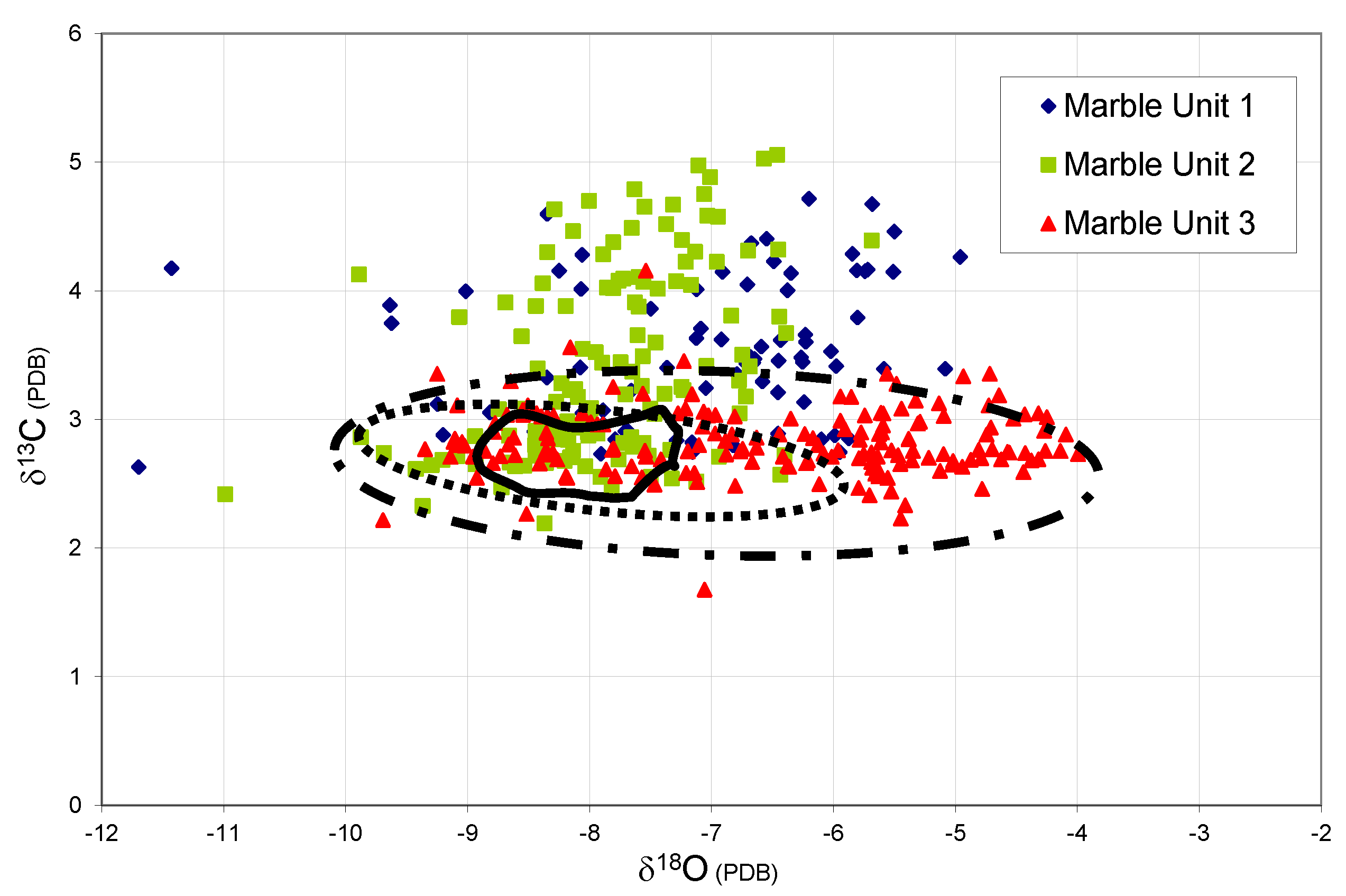
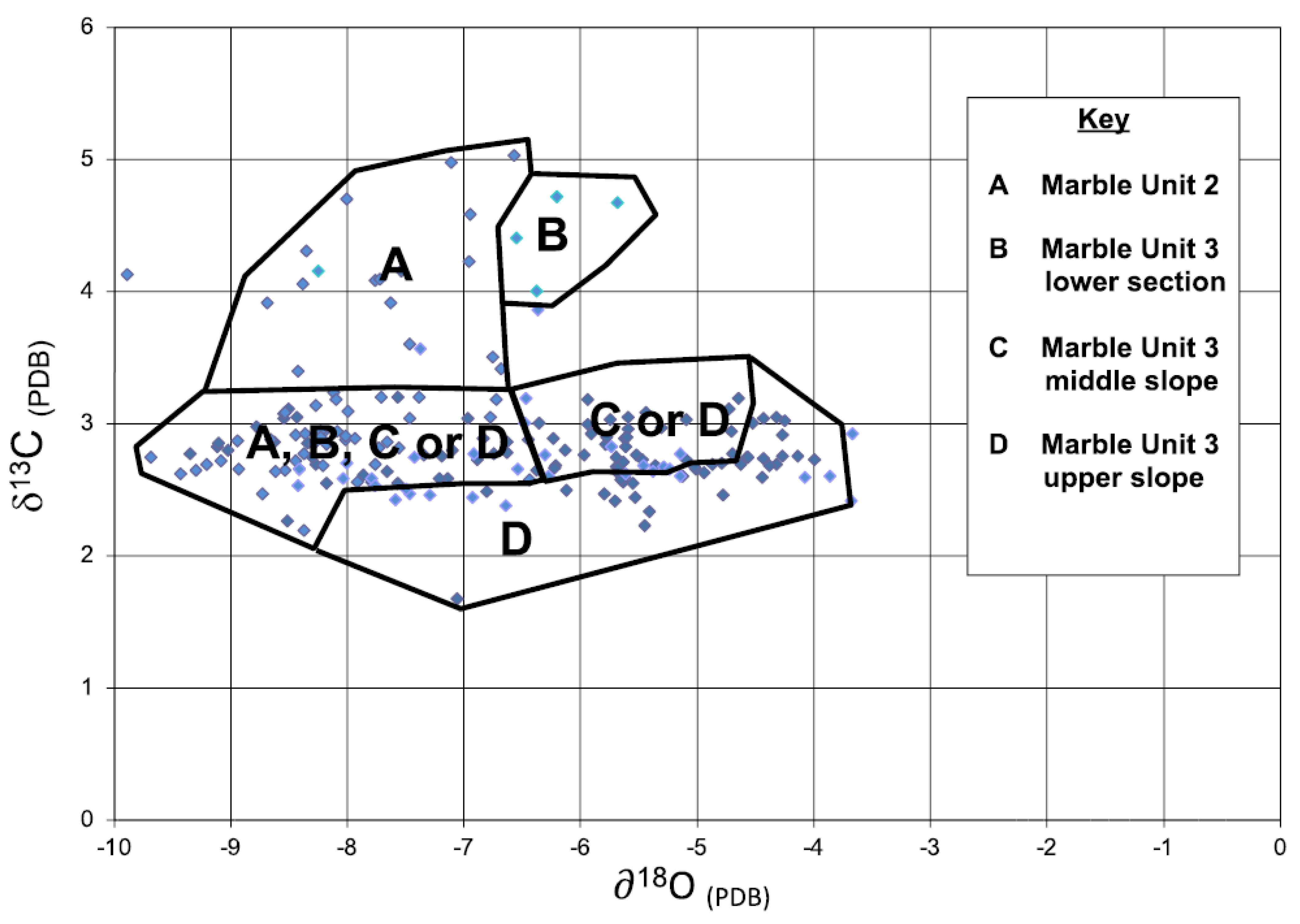

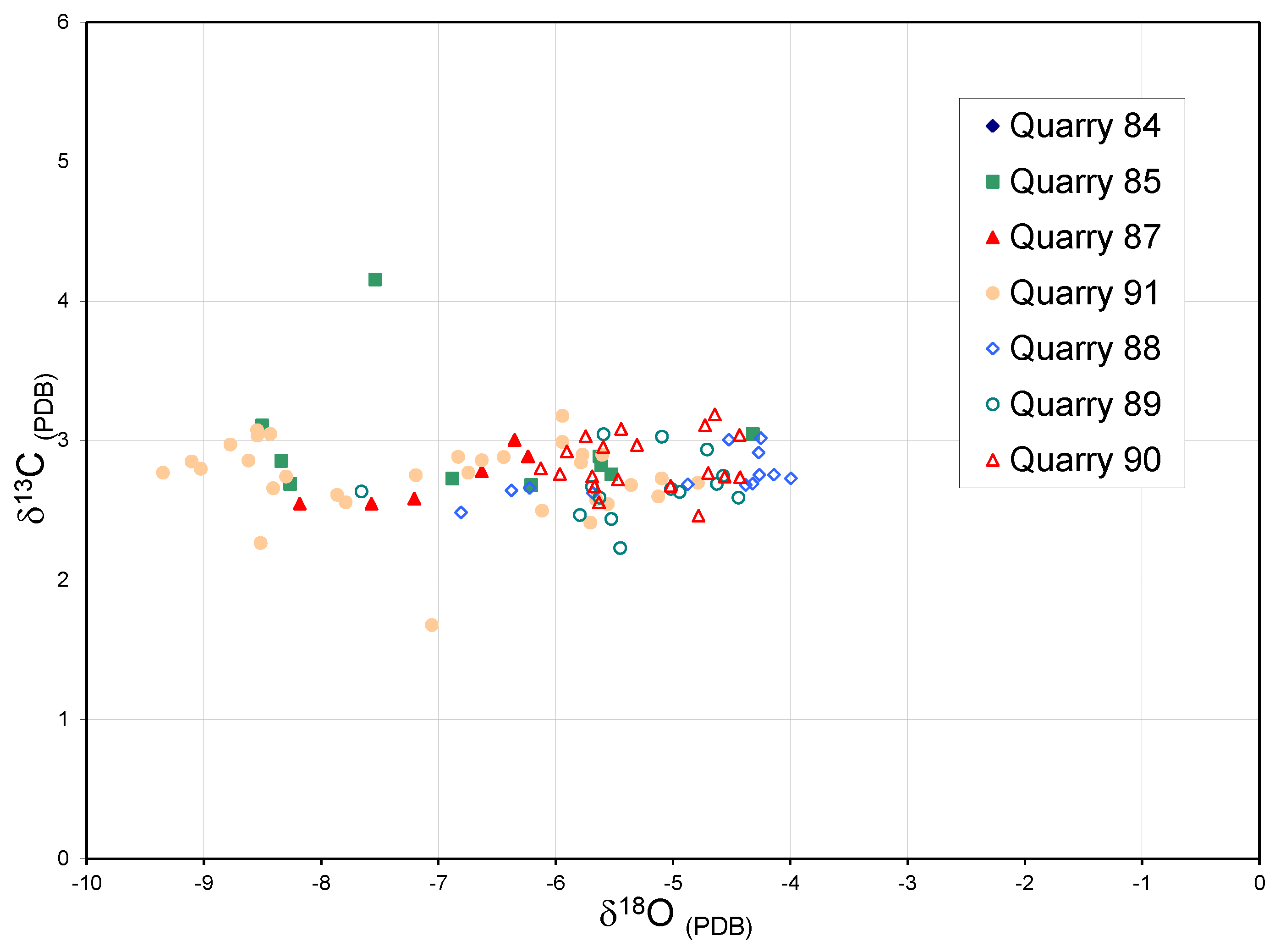

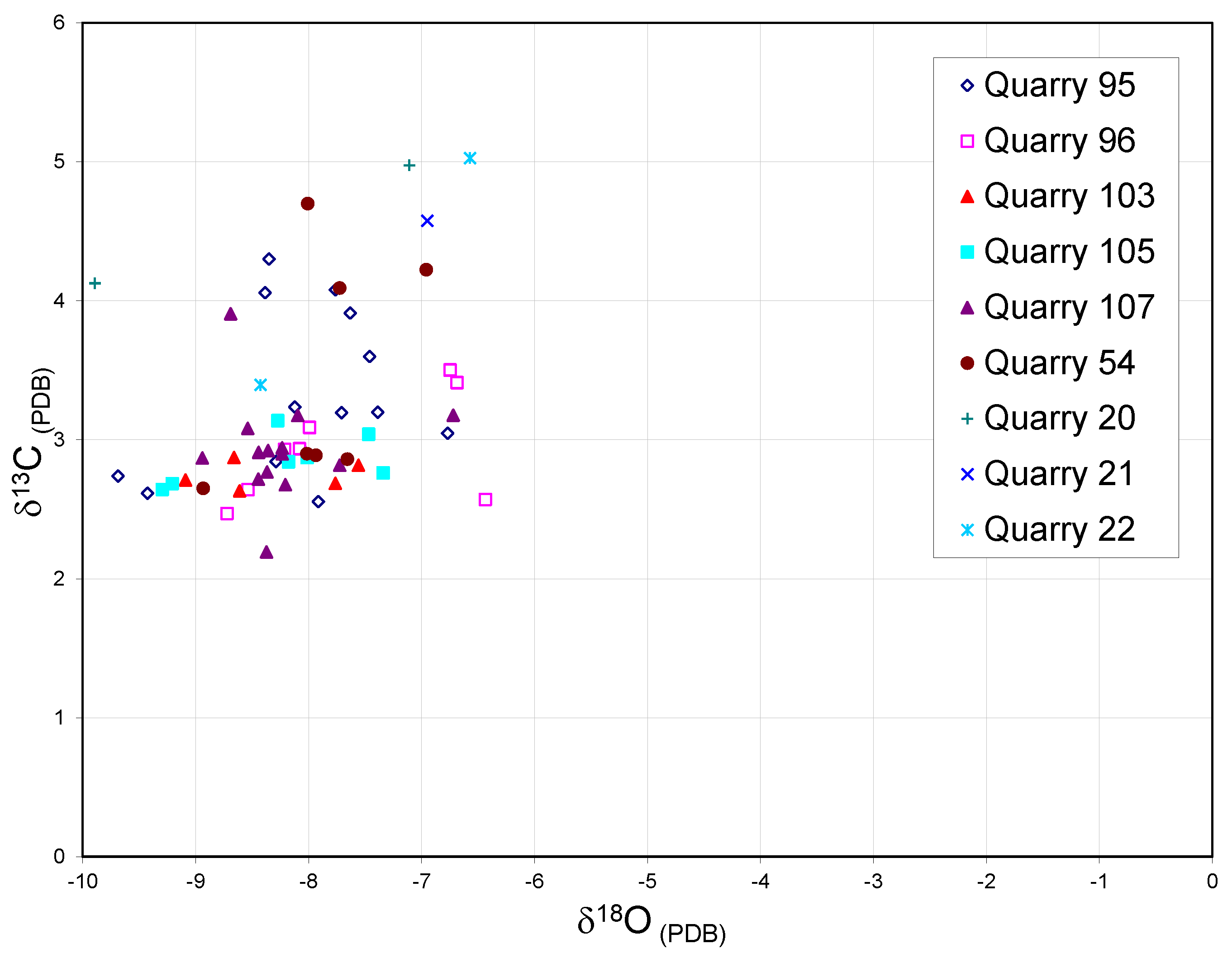

Disclaimer/Publisher’s Note: The statements, opinions and data contained in all publications are solely those of the individual author(s) and contributor(s) and not of MDPI and/or the editor(s). MDPI and/or the editor(s) disclaim responsibility for any injury to people or property resulting from any ideas, methods, instructions or products referred to in the content. |
© 2025 by the author. Licensee MDPI, Basel, Switzerland. This article is an open access article distributed under the terms and conditions of the Creative Commons Attribution (CC BY) license (https://creativecommons.org/licenses/by/4.0/).
Share and Cite
Pike, S. Characterization of Intra-Quarry Variability in Pentelic Marble Using Stable Isotopes: A Case Study of the Parthenon. Minerals 2025, 15, 231. https://doi.org/10.3390/min15030231
Pike S. Characterization of Intra-Quarry Variability in Pentelic Marble Using Stable Isotopes: A Case Study of the Parthenon. Minerals. 2025; 15(3):231. https://doi.org/10.3390/min15030231
Chicago/Turabian StylePike, Scott. 2025. "Characterization of Intra-Quarry Variability in Pentelic Marble Using Stable Isotopes: A Case Study of the Parthenon" Minerals 15, no. 3: 231. https://doi.org/10.3390/min15030231
APA StylePike, S. (2025). Characterization of Intra-Quarry Variability in Pentelic Marble Using Stable Isotopes: A Case Study of the Parthenon. Minerals, 15(3), 231. https://doi.org/10.3390/min15030231






